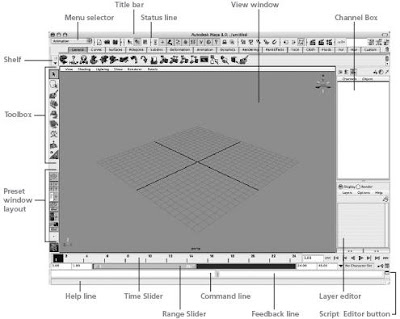Maya Interface

The Title Bar
The title bar displays the Maya version number, the name of the scene you are working on, and the name of any object you have selected. It also includes standard Minimize and Maximize buttons and a Close button.
The Menu Bar
The menu bar lets you quickly access numerous functions in Maya via pull-down menus. The contents of each pull-down menu give you access to related tools, commands, and settings, and, when available, the menu lists the keyboard shortcuts for executing tools or commands.
Because Maya has so many menus, they won’t all fit in a single-row menu bar. The Maya interface solves this space problem by partitioning menus in menu sets. A menu set is divided up based on tools and commands related to a particular workflow.
There are five menu sets available in Maya Complete:
- Animation
- Polygons
- Surfaces
- Dynamics, and
- Rendering
Maya Unlimited has one additional menu set for Cloth. You can access these menu sets from the menu selector’s drop-down list on the status line, as shown in the illustration. After you have selected a menu set, you will notice that some of the options in the menu bar will change according to the set you chose.
You can also choose a menu set by pressing the H key while you hold down the left mouse button in the view window. A marking menu will appear, containing each menu set. You can choose the set you want by releasing the left mouse button when the cursor is over the appropriate set.
Regardless of the menu sets you’re using, the File, Edit, Modify, Create, Display, Window, and Help menu options will always appear in the menu bar. These items are not specific to any particular workflow.
Instead, they give you access to many of the common editing commands found in most software packages (such as Cut, Copy, Paste, Save, and Close) and allow you to create new objects (the Create menu), modify these objects (the Modify menu), access different windows (the Window menu), and choose how objects are displayed in the view window (the Display menu).
Tools and Commands. Tools and commands (also called actions) are two different things in Maya. As you browse though Maya’s menus, you’ll notice that some of the items listed include the word tool and others do not. The differences between a tool and a command are subtle.
For example, the Create menu includes a tool called the CV Curve tool. When the tool is selected from the menu, Maya enters a mode in which that tool is active. In the case of the CV Curve tool, a control vertex is created each time you click your mouse button in the view window.
To finish using the tool, you must press the ENTER (RETURN) key. A command, on the other hand, can require some sort of input before it can be selected from a menu. The Edit | Duplicate command is a good example.
Before you can select the Duplicate command from the Edit menu, you first must select an object or objects that you wish to duplicate. After the selections have been made, you can choose the command from the Edit menu and it is executed.
The result, of course, is a duplicate of the selected object(s), and that’s it— the operation executed by the Duplicate command did its job and you can move on to your next task. Some commands don’t require any input—they simply create an object when they’re executed. For example, the Create | Locator command simply creates a locator.
Tool Options and Command Settings. Another element that can be found next to some of the tools and commands in the menus is a rectangular box icon. Selecting this icon will open either the Options window for a command or the Tool Settings window for tools. The Options window will always open as a floating window. Here you can modify the settings for the specified command and then execute it.